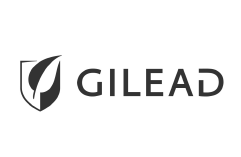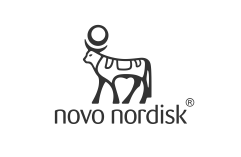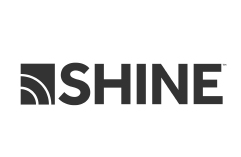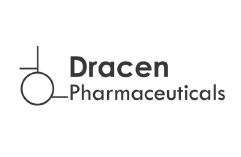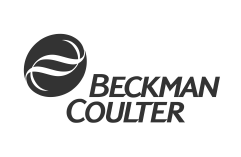Lipophosphonoxins Active
Novel broad-spectrum antimicrobial agents to overcome bacterial resistance
Scientists:
Principal Investigator: Dominik Rejman (IOCB Prague). Team IOCB Prague: Magdalena Petrová, Viktor Mojr, Nitjawan Sahatsapan, Ivana Markusová Kóšiová, Eva Dávidová. Collaboration: Libor Krásný (MBI), Milan Kolář (UPOL), David Lukáš (TUL), Peter Gál (LF3 UK), Radovan Fišer (UK)
CHALLENGE
Growing antimicrobial resistance poses a significant threat to public health worldwide. A recent review of the antibiotic pipeline by the World Health Organization (WHO, 2022) states that the current clinical pipeline is insufficient to tackle the challenge of increasing emergence and spread of antimicrobial resistance. Innovative solutions are urgently needed.
KEYWORDS
antimicrobial resistance infectious diseases nanomaterial wound dressing
Neurosteroids for the treatment of epilepsy Active
Scientists:
Scientists: Principal Investigator: Eva Kudová (IOCB Prague). Team IOCB Prague: Hana Chodounská, Ewa Szczurowska. Team IPHYS: Hana Kubová, Pavel Mareš
CHALLENGE
Epilepsy is an umbrella term covering a wide range of syndromes and conditions which manifest with seizures. Pharmacoresistant (refractory) epilepsy is defined as failure to achieve seizure freedom following adequate trials of two tolerated and appropriately chosen antiepileptic drugs. Among epilepsy patients, 30% or more are considered pharmacoresistant. Pharmacoresistant epilepsy can have a devastating effect on the patient’s quality of life and is associated with an increased risk of sudden unexpected death.
KEYWORDS
neurosteroids epilepsy seizures pharmacoresistance GABAA
CHEESE – Chemical Embeddings Search Engine Active
Unique AI-based super-fast search in chemical space
Scientists:
Scientists: Miroslav Lžičař, Hamza Gamouh, Martin Culka, Jan Skácel, Jan Macek
CHALLENGE
The ability to rapidly search and analyze large databases of molecules for similar compounds have revolutionized drug discovery and chemical informatics. Searching large databases using traditional means is, however, extremely slow, and therefore intractable. To address those shortcomings, we developed a new fast and scalable tool: CHEESE (Chemical Embeddings Search Engine) for searching very large chemical spaces.
The AI-based tool learns molecule representations and has the potential to be trainable and flexible to many molecule similarity aspects (2D, 3D, ...). Furthermore, the learned molecule representations can be leveraged for multiple downstream tasks such as molecular property prediction.
KEYWORDS
artificial intelligence machine learning large chemical space similarity search virtual screening
α-Synuclein aggregation inhibitor for Parkinson's disease treatment Active
Scientists:
Volodymyr Shvadchak, Maksym Galkin
CHALLENGE
Parkinson's disease (PD) is a neurodegenerative disorder that impacts over 1% of individuals aged 60, and more than 4% of those aged 80 and above. Despite the increasing demand, a cure for PD remains elusive, with only symptomatic treatments currently available. The progression of PD is heavily driven by the aggregation of small protein α-synuclein (αSyn) into amyloid fibrils that makes stopping this process a prospective strategy for the disease treatment.

KEYWORDS
Parkinson's disease α-Synuclein aggregation amyloid fibrils FEPI
Inhibiting purine nucleoside phosphorylase to treat T-cell malignancies – a viable approach or not? Active
Scientists:
Principal Investigator: Zlatko Janeba (IOCB Prague). PNP Team (IOCB Prague): Jan Skácel, Michal Česnek, Pavel Kraina, Helena Mertlíková-Kaiserová, Jaroslav Kozák, Pavlína Maloy Řezáčová
CHALLENGE
T-cell leukemias/lymphomas are a clinically heterogenous group of rare, but often aggressive malignancies. Current treatment options for T-cell leukemias/lymphomas are limited, especially for patients who have relapsed after the first-line treatment. The median overall survival for relapsed peripheral T-cell lymphoma has been estimated at ca. 6 months (Mak 2013; DOI: 10.1200/JCO.2012.44.7524).
Purine nucleoside phosphorylase (PNP) is a ubiquitous enzyme required for purine metabolism. T-cell proliferation is known to be crucially dependent on the PNP activity. Thus, effective PNP inhibition could be beneficial in conditions characterized by malignant T-cell growth. The first (and so far only) marketed PNP inhibitor, forodesine, is currently available only in Japan (as of Jan 2021, brand name Mundesine).
Beside T-cell malignancies, PNP has been proposed as a potential therapeutic target for the treatment of bacterial and parasitic infections (Mycobacterium tuberculosis, Plasmodium falciparum).
KEYWORDS
purine nucleoside phosphorylase (PNP) T-cell leukemia T-cell lymphoma
Neurosteroids in neuropathic pain treatment Active
Scientists:
Eva Kudová (PI), Ewa Szczurowska, Jiří Paleček, Jan Jakubík
CHALLENGE
Neuropathic pain remains a therapeutic area with unmet medical needs. There is about 7% of the population suffering from neuropathy caused by diabetes, chemotherapy, ischemia, spinal cord injury or herpes. According to the clinical evidence, 40% of those people get only partial pain relief from available medicaments like analgesics, Lyrica, duloxetine, opioids or Qutenza.
Searching for novel drugs potentially useful for therapy of CNS damage belongs to the most investigated topics in contemporary pharmacology and neuroscience. The proposed project is based on the study of biological properties of newly developed 3αC substituted derivatives of pregnanolone and the evaluation of their pharmacotherapeutic potential. The current medical treatment of the Neuropathic Pain relies on the ion channel blockers (Gabapentin, Pregabalin) or the serotonin up-take blockers (Duloxetine) or the NMDA antagonists (Memantine, Dextromethorphan). Since direct antagonists or agonists or channel blockers can also severely influence physiological functions, they do have serious adverse side effects during the treatment. Our approach is focused on the allosteric modulation of the neuro-receptors, which is milder and only changes the sensitivity of the neuro-receptors to endogenous neurotransmitters or agonists.
KEYWORDS
neuropathic pain opioid receptors steroids pain relief neurosteroids allosteric modulation
An alternative pathway C5 convertase inhibitor for treatment of complement hyperactivation in humans Active
Scientists:
Sebastian Zoll, Hagen Sülzen
CHALLENGE
Excessive activation of the innate immune response has been implicated as a significant contributing factor in the pathogenesis of numerous diseases. These include e.g. autoimmune diseases, Alzheimer's syndrome, schizophrenia, atypical hemolytic-uremic syndrome, angioedema, macular degeneration, and Crohn's disease. The three conditions, atypical hemolytic uremic syndrome (aHUS), C3 glomerulopathy (C3G), and paroxysmal nocturnal hemoglobinuria (PNH), exemplify the consequences of complement dysregulation disorders, which arise due to underlying genetic abnormalities. In each case, the complement system, a vital component of the immune system responsible for host defence and regulation, is affected by genetic mutations. Complement hyperactivation disrupts cellular self-recognition, leading to uncontrolled lysis of red blood and endothelial cells, which can ultimately result in kidney failure.
The different complement pathways and the mode of PX action:
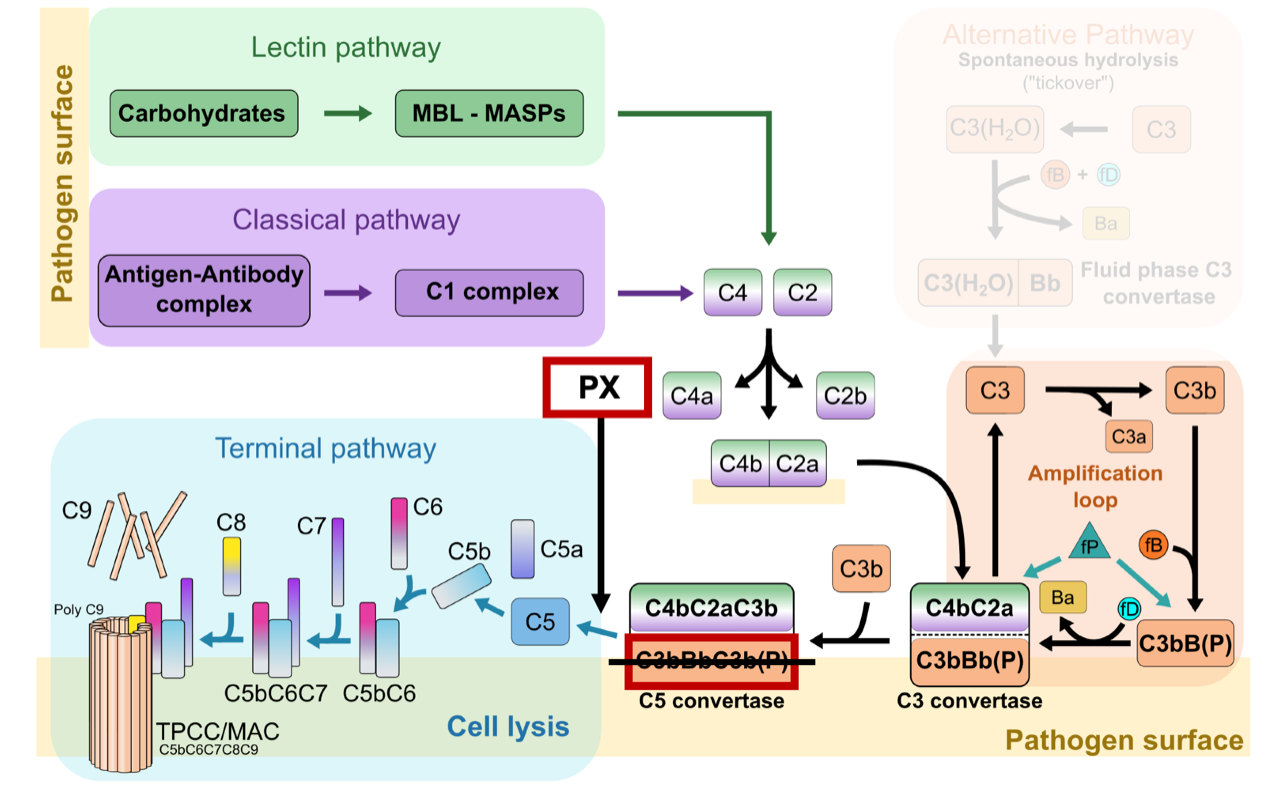
The classical (CP) and the lectin pathway (LP) are triggered by specific antigens on pathogen surfaces. The alternative pathway (AP) can start spontaneously by a nucleophilic attack of water on metastable native C3, resulting in generation of the fluid phase C3 convertase, but it also serves as an amplification pathway after CP and LP. CP and LP share the same C3 and C5 convertases CP/LP C4bC2a and CP/LP C4bC2aC3b, respectively. Analogue to C3b of the AP C3 convertase, CP/LP C3 convertase formation is initiated by covalent binding of thioester-containing C4b to the pathogen membrane. Both CP/LP convertases are structurally distinct from the AP C3 and C5 convertases AP C3bBb(P) and AP C3bBbC3b(P), but have the same substrate specificities. Properdin stabilises the AP convertases. Cleavage of C5 initiates the terminal pathway. C5b sequentially binds C6, C7, C8 and poly-C9 and inserts into the plasma membrane where it forms a lytic pore, the membrane attack complex. PX binding to C3b inhibits the AP C5 convertase. This restricts the AP and blocks progression to the TP. PX leaves the CP, LP and the amplification loop unaffected. MBL, Mannan-binding lectin; MASP, MBL-associated serine proteases; fB, factor B; fD, factor D; Ba, factor B fragment a; Bb, factor B fragment b; fP, factor P (properdin); MAC, membrane attack complex; TPCC terminal pathway complete complex.
KEYWORDS
complement system alternative pathway inhibitor PX C3 glomerulopathy
iBodies – Synthetic antibodies Active
Scientists:
Pavel Šácha, Tereza Ormsby
CHALLENGE
Medical treatment based on antibodies can be in general very efficient, however, it is very expensive, it may induce adverse immune reactions and it is usually very narrowly targeted lacking thus versatility. There is always some group of non-responders as well as a group of patients with exaggerated reaction to the antibody treatment. Artificial synthetic antibodies – iBodies may overcome these drawbacks and even bring some new positive features into the therapy.
KEYWORDS
iBodies synthetic antibodies
